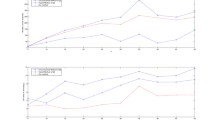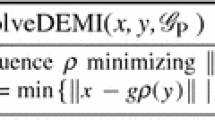Abstract
We propose a new geometric buildup algorithm for the solution of the distance geometry problem in protein modeling, which can prevent the accumulation of the rounding errors in the buildup calculations successfully and also tolerate small errors in given distances. In this algorithm, we use all instead of a subset of available distances for the determination of each unknown atom and obtain the position of the atom by using a least-squares approximation instead of an exact solution to the system of distance equations. We show that the least-squares approximation can be obtained by using a special singular value decomposition method, which not only tolerates and minimizes small distance errors, but also prevents the rounding errors from propagation effectively, especially when the distance data is sparse. We describe the least-squares formulations and their solution methods, and present the test results from applying the new algorithm for the determination of a set of protein structures with varying degrees of availability and accuracy of the distances. We show that the new development of the algorithm increases the modeling ability, and improves stability and robustness of the geometric buildup approach significantly from both theoretical and practical points of view.
Similar content being viewed by others
References
Biswas, P., Liang, T., Wang, T., Ye, Y., 2006. Semidefinite programming based algorithms for sensor network localization. ACM J. Trans. Sensor Netw. 2, 188–220.
Biswas, P., Liang, T., Toh, K., Ye, Y., 2007. A SDP based approach to anchor-free 3D graph realization. Department of Management Science and Engineering, Electrical Engineering, Stanford University, Stanford, California.
Blumenthal, L.M., 1953. Theory and Applications of Distance Geometry. Clarendon, Oxford.
Crippen, G.M., Havel, T.F., 1988. Distance Geometry and Molecular Conformation. Wiley, New York.
Dong, Q., Wu, Z., 2002. A linear-time algorithm for solving the molecular distance geometry problem with exact inter-atomic distances. J. Global Optim. 22, 365–375.
Dong, Q., Wu, Z., 2003. A geometric buildup algorithm for solving the molecular distance geometry problem with sparse distance data. J. Global Optim. 26, 321–333.
Glunt, W., Hayden, T.L., Hong, S., Wells, J., 1990. An alternating projection algorithm for computing the nearest Euclidean distance matrix. SIAM J. Matrix Anal. Appl. 11, 589–600.
Glunt, W., Hayden, T.L., Raydan, M., 1993. Molecular conformations from distance matrices. J. Comput. Chem. 14, 114–120.
Golub, G.H., van Loan, C.F., 1989. Matrix Computations. Johns Hopkins Press, Baltimore.
Grosso, A., Locatelli, M., Schoen, F., 2007. Solving molecular distance geometry problems by global optimization algorithms. J. Comput. Opt. Appl. 43, 22–37.
Havel, T., 1991. An evaluation of computational strategies for use in the determination of protein structure from distance constraints obtained by nuclear magnetic resonance. Prog. Biophys. Molec. Biol. 56, 43–78.
Havel, T.F., 1995. Distance geometry. In: Grant, D.M., Harris, R.K. (Eds.), Encyclopedia of Nuclear Magnetic Resonance, pp. 1701–1710. Wiley, New York.
Havel, T.F., 1998. Distance geometry: Theory, algorithms, and chemical applications. In: Encyclopedia of Computational Chemistry, pp. 1–20. Wiley, New York.
Hendrickson, B., 1992. Conditions for unique graph realizations. SIAM J. Comput. 21, 65–84.
Hendrickson, B., 1995. The molecule problem: Exploiting structure in global optimization. SIAM J. Optim. 5, 835–857.
Hou, J.T., Sims, G.E., Zhang, C., Kim, S.H., 2003. A global representation of the protein fold space. Proc. Natl. Acad. Sci. USA 100, 2386–2390.
Huang, H.X., Liang, Z.A., Pardalos, P., 2003. Some properties for the Euclidean distance matrix and positive semi-definite matrix completion problems. J. Global Optim. 25, 3–21.
Kearsly, A., Tapia, R., Trosset, M., 1998. Solution of the metric STRESS and SSTRESS problems in multidimensional scaling by Newton’s method. Comput. Stat. 13, 369–396.
Klock, H., Buhmann, J.M., 1997. Multidimensional scaling with deterministic annealing. In: Pilillo, M., Hancock, E.R. (Eds.), Energy Minimization Methods in Computer Vision and Pattern Recognition, Lecture Notes in Computer Science, vol. 1223, pp. 246–260. Springer, Berlin.
Le Thi Hoai, A., Pham Dinh, T., 2003. Large scale molecular optimization from distance matrices by a d.c. optimization approach. SIAM J. Optim. 4, 77–116.
Moré, J., Wu, Z., 1996. ε-Optimal solutions to distance geometry problems via global continuation. In: Pardalos, P.M., Shalloway, D., Xue, G. (Eds.), Global Minimization of Non-Convex Energy Functions: Molecular Conformation and Protein Folding, pp. 151–168. Am. Math. Soc., Providence.
Moré, J., Wu, Z., 1997. Global continuation for distance geometry problems. SIAM J. Optim. 7, 814–836.
Moré, J., Wu, Z., 1999. Distance geometry optimization for protein structures. J. Global Optim. 15, 219–234.
Saxe, J.B., 1979. Embeddability of weighted graphs in k-space is strongly NP-hard. In: Proc. 17th Allerton Conference in Communications, Control and Computing, pp. 480–489.
Sippl, M., Scheraga, H., 1985. Solution of the embedding problem and decomposition of symmetric matrices. Proc. Natl. Acad. Sci. USA 82, 2197–2201.
Sippl, M., Scheraga, H., 1986. Cayley-Menger coordinates. Proc. Natl. Acad. Sci. USA 83, 2283–2287.
Torgerson, W.S., 1958. Theory and Method of Scaling. Wiley, New York.
Trosset, M., 1998. Applications of multidimensional scaling to molecular conformation. Comput. Sci. Stat. 29, 148–152.
Wu, D., Wu, Z., 2007. An updated geometric buildup algorithm for solving the molecular distance geometry problem with sparse distance data. J. Global Optim. 37, 661–673.
Zou, Z., Byrd, R.H., Schnabel, R.B., 1997. A stochastic/perturbation global optimization algorithm for distance geometry problems. J. Global Optim. 11, 91–105.
Author information
Authors and Affiliations
Corresponding author
Additional information
Work supported by the NIH/NIGMS grant R01GM081680, and the NSF grant of China.
Rights and permissions
About this article
Cite this article
Sit, A., Wu, Z. & Yuan, Y. A Geometric Buildup Algorithm for the Solution of the Distance Geometry Problem Using Least-Squares Approximation. Bull. Math. Biol. 71, 1914–1933 (2009). https://doi.org/10.1007/s11538-009-9431-9
Received:
Accepted:
Published:
Issue Date:
DOI: https://doi.org/10.1007/s11538-009-9431-9




